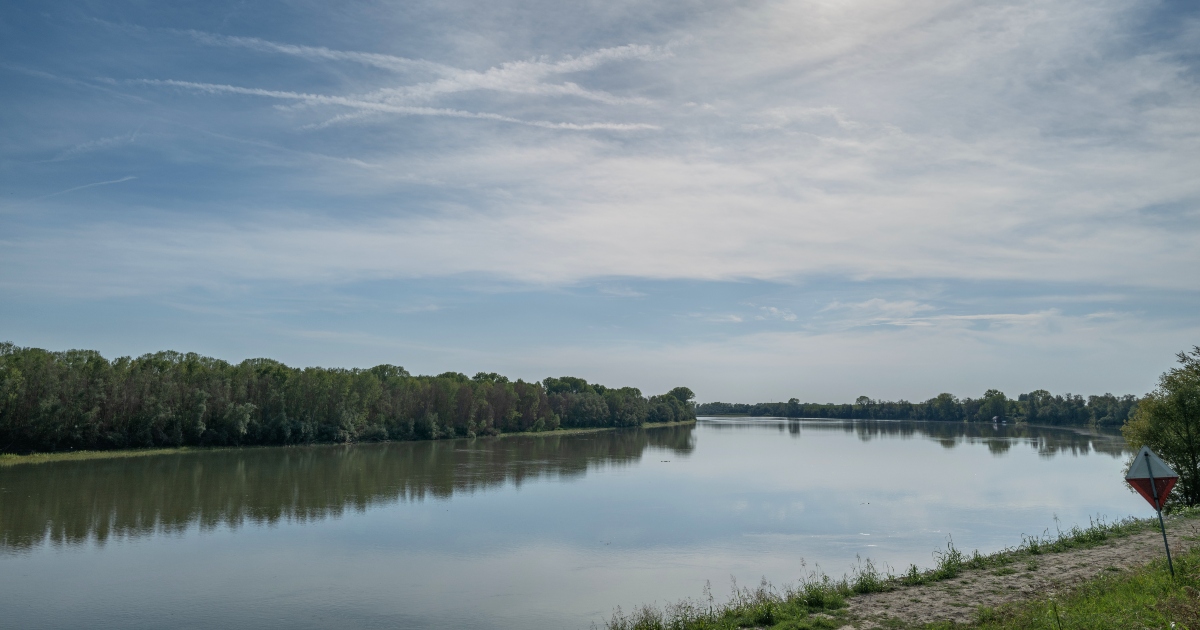IUCN: “A quarter of freshwater species at risk of extinction”

The Po River in Guarda Veneta. Photo: Giorgio Galeotti/Wikimedia Commons
Freshwater ecosystems – river, lakes, ponds, and wetlands – cover less than 1% of the Earth’s surface, yet they are true treasure troves of biodiversity. These environments are home to over 10% of global biodiversity, including about one third of all vertebrates and more than half of all fish species. Moreover, freshwater ecosystems provide essential ecosystem services for humans: they play a crucial role in flood control, help mitigate climate change, and are central to the nutrient cycles. They also support the culture and livelihoods of billions of people worldwide.
Yet, freshwater ecosystems remain among the most neglected in nature conservation efforts. Between 1970 and 2015, 35% of the world’s wetlands were lost – a rate of destruction three times faster than deforestation, a problem that, luckily, has long received public attention. The wetlands that do remain are not in good health: 65% are at moderate or high risk, and 37% of rivers longer than 1,000 km have been at least partially altered by human activity.
All these findings come from a groundbreaking study published in the scientific journal Nature, which, for the first time, provides a global assessment of the health status of animal species living in freshwater ecosystems.
Watch the interview with Leonardo Congiu. Interview by Sofia Belardinelli, filming and editing by Massimo Pistore. We thank Paolo Bronzi for the sturgeon footings.
Freshwater environments: a secondary concern in conservation
Backed by the IUCN (International Union for the Conservation of Nature), this research – coauthored by 88 experts – presents the first global assessment of the extinction risk levels faced by freshwater species. It is a crucial piece of knowledge for shaping conservation efforts, filling a major gap in our understanding of the biodiversity crisis.
As the study’s authors highlight, global assessments for taxonomic groups such as birds, amphibians, mammals, and, more recently, reptiles have been conducted and frequently updated over the past two decades. However, “generation of global data and assessments for freshwater fishes and invertebrates has received comparatively little investment, political will or attention, including from the mainstream conservation community”.
As a result, conservation measures for freshwater ecosystems have often been imprecise and, consequently, ineffective. Moreover, the authors emphasise that “until recently, the freshwater realm has not been given the same priority as the terrestrial and marine realms in global environmental governance”.
24% of freshwater species face extinction
The results of this global assessment are alarming, though not unexpected, and align with the broader biodiversity crisis affecting both terrestrial and marine environments. Analysing the conservation status of approximately 23,500 freshwater species across three taxonomic groups – decapods, dragonflies (odonates), and fish – researchers found that nearly a quarter (24%) are at risk of extinction based on IUCN categories. Among these, decapods face the highest threat (30% of assessed species), followed by fish (26%) and odonates (16%).
Moreover, these figures may represent a conservative estimate, as the assessment does not cover all freshwater groups. For example, freshwater molluscs were not included, despite a partial evaluation suggesting that around one third of their species may be at risk of extinction, with an estimated quarter of critically endangered species potentially being already extinct.
The authors of the assessment also caution that “the true number of extinctions of freshwater species” – with 89 documented extinctions since 1500 and 11 species now extinct in the wild but surviving in captivity – “will probably be higher given the overall lack of research on and long-term monitoring of freshwater biodiversity”.
Conservation and restoration
The publication of this first global assessment is a major milestone, as emphasised by Leonardo Congiu, professor of ecology at the University of Padua and co-author of the study in his role as coordinator of the IUCN Sturgeon Specialist Group. Congiu explains that the IUCN, the world’s largest institution dedicated to studying and protecting biodiversity, plays a crucial role in classifying species into different risk categories. These classifications serve as the foundation for conservation strategies and the allocation of available financial resources.
“This assessment,” Congiu explains, “is the synthesis of many years of work and has involved thousands of experts gathering essential information on their respective taxonomic groups. This is a voluntary commitment that specialists take on regularly. For example, I led the group focusing on sturgeons. Our most recent assessment was published in 2022, and like many other groups, we found a clear negative trend in sturgeon populations.” Sturgeons, Congiu continues, are a “flagship species” for the health of freshwater biodiversity. With 26 species, they are currently the most endangered group of fish in the world.
Despite this gloomy picture, a glimmer of hope comes from Italy. Historically, three species of sturgeon were found in Italian waters. Two of them—the beluga sturgeon (Huso huso) and the common sturgeon (Acipenser sturio)—are now locally extinct. However, the Adriatic sturgeon (Acipenser naccarii), the smallest and least commercially valuable of the three, is still present. Over the past 30 years, various conservation efforts—though not always well-coordinated—have yielded significant results. While all other sturgeon species continue to decline, the Adriatic sturgeon is the only one showing a positive trend, moving from the category of “extinct in the wild” to just “critically endangered.”
It is a notable achievement, Congiu notes, especially considering the poor state of freshwater environments in Italy. “Our rivers, for example, are in a state of total devastation,” he says. “Many waterways are dammed to store water for energy production, agriculture, industry, or urban use. These barriers severely impact species like sturgeons, which need to migrate upstream to spawn. Additionally, by altering hydrological regimes, dams drastically modify river ecosystems both upstream and downstream.”
Over the centuries, Italian rivers have been heavily diverted, channelled, and straightened to meet human needs. This has limited their natural dynamics, prevented necessary flooding, and disrupted the surrounding ecosystems. “These modifications,” Congiu explains, “have shortened rivers and turned them into ‘pipes’ where water flows much faster than it should. This not only reduces their ability to filter pollutants but also makes them less effective in mitigating extreme weather events. With increasingly frequent abnormal rainfall, these highly artificial rivers struggle to absorb excess water, increasing the risk of hydrogeological disasters.”
“This situation,” he adds, “also affects biodiversity. The containment of waterways has led to the disappearance of crucial ecosystems, such as oxbow lakes and floodplains, which play a vital role in the life cycles of many species. Another major issue affecting Italy’s freshwater ecosystems is the presence of a vast number of non-native species, often introduced for sport fishing, which have a devastating impact on native biodiversity.”
To safeguard freshwater ecosystems and reduce natural disasters, a complete paradigm shift in conservation is needed. “Conservation should focus on restoring natural conditions, re-establishing both longitudinal connectivity (along the river’s course) and lateral connectivity with surrounding habitats,” says Congiu. Some progress is being made in Italy, and if properly guided, these efforts could yield positive results. “Many European funds from the National Recovery and Resilience Plan (PNRR) have been allocated to projects aimed at restoring parts of the Po River. Additionally, the National Biodiversity Future Centre is a major research initiative involving hundreds of scientists across the country, with the goal of contributing to biodiversity conservation by first achieving a comprehensive understanding of it. One of the first key outcomes will be a complete assessment of Italy’s biodiversity, which is far less studied than one might expect.”
Strategies to protect freshwater ecosystems
Expanding our knowledge of biodiversity is crucial not only at the local level but also on a global scale. The study published in Nature not only provides new data but also clarifies the most effective methods for assessing the conservation status of freshwater species. Until now, extinction risk for these species and ecosystems has often been estimated using “proxies” – indirect indicators assumed to be reliable enough to apply to freshwater environments and species. One of the most commonly used proxies has been the conservation status of tetrapods (amphibians, reptiles, birds, and mammals). While researchers found this method to be imperfect, it was still deemed more reliable than another frequently used proxy – the health of ecosystems based on abiotic factors, such as water eutrophication or human-caused degradation – which was deemed entirely unreliable.
“Relying on these surrogates for conservation and management decisions could lead to suboptimal or even harmful outcomes and, therefore, conservation strategies that rely on abiotic indicators should be re-evaluated,” the study states.
“The key message of this research,” explains Congiu, “is that we need conservation strategies specifically designed for freshwater ecosystems and species.” In other words, these environments must receive the attention and recognition they deserve given their critical role in global biodiversity.
Some progress has already been made in this direction. The Global Biodiversity Framework – a non-binding international agreement signed by UN member states in 2022 to set biodiversity conservation priorities for 2020-2030 – explicitly designates “inland waters” as a distinct conservation target, separate from terrestrial and marine environments. While this recognition is significant, it is far from sufficient.
The freshwater ecosystem experts who conducted this first global assessment are calling for stronger efforts to protect these environments. “As the next step,” the researchers state in the article, “it is important that availability of this new dataset is communicated to all relevant stakeholders,” from local authorities to international institutions. They also stress the need to support these stakeholders in integrating this knowledge into conservation policies, bridging the gap between scientific research and concrete, data-driven management strategies to benefit freshwater species and ecosystems.









